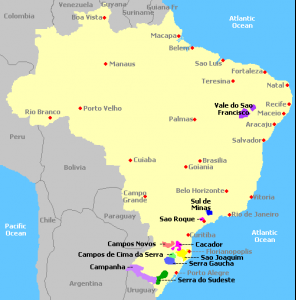
Brazil is the third producer in South America, after Chile and Argentina. Wine production was introduced by the Portuguese settlers in the middle of the XVIth century South of Sao Paulo. In the 1870’s, the massive arrival of Italian settlers resulted in new developments. In modern days, it is in the 1970s that wine production started really booming, with the arrival of multinational companies. The Brazilian wines show real qualitative progress, supported by national demand and the economic dynamism of this South American “giant”. The production of good sparkling wines ( Charmat and traditional methods) are a specialty of this promising country.
Surface : 91 000 ha
Production : 2,9 Mhl
Consumption : 3,4 Mhl
Terroir :
Main wine regions
Legislation
Sites :